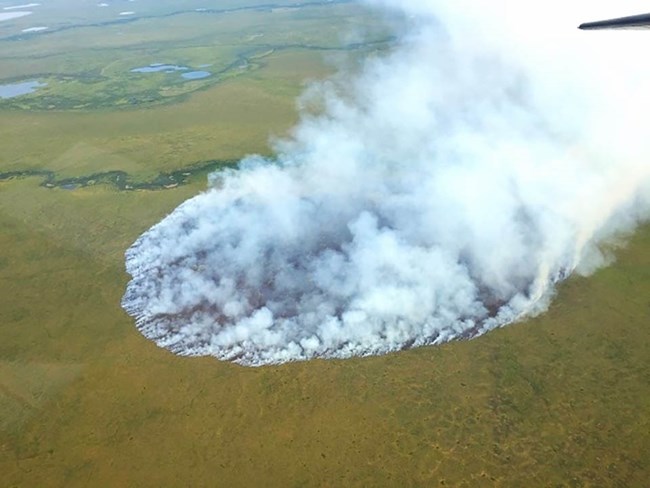
Despite the long, severe winters and relatively short summers, wildland fires do occur and are a natural part of the ecosystem. While tundra fires occur infrequently due to the lack of vegetation to burn in the rocky or sparsely vegetated alpine tundra or the wet coastal plains, it can happen under the right conditions. The most frequent and largest fires occur in forested areas and the interior lightning belt where fire is a significant, natural process.
Both black and white spruce depend on intense ground fire to clear organic layers and expose fertile seedbeds. At the peak of the Alaskan Interior fire season in June and July, black spruce seeds become ready for germination. Seeds are released when canopy fire opens the cones. Black spruce semi-serotinous cones rely, at least partially, on high-intensity fires in order to open. White spruce colonizes mineral soil seedbeds after intense ground fires. Aspen and birch trees can resprout after low severity fires, but may also seed in after a high severity fire.
Fire also plays a key role in the regulation of the permafrost table throughout this area. Without fire, organic matter accumulates, the permafrost table rises, and ecosystem productivity declines. Vegetation communities become less diverse and wildlife habitat decreases; fire rejuvenates these systems. It removes insulating organic matter and elicits a warming of the soil. Combustion and increased decomposition rates return nutrients to the soil. What at first looks like devastation soon blooms into a bounty of life.
Changes in vegetation due to fires, in turn, affect wildlife distribution and habitat use. Patchy fires create a mosaic of habitats frequently used by snowshoe hares and martens, while moose often browse on resprouting willow, aspen or birch after fires. Small mammals, such as voles, often thrive in recently burned areas, creating large colonies in the remaining duff and feeding on new vegetation. Caribou, on the other hand, may tend to avoid recently burned areas lacking sufficient lichen for winter forage. Lichens take a longer time to regrow, often 100-150 years to recover. Ultimately, these fire-related changes to wildlife habitat and animal distribution also affects subsistence users who rely on the availability of these animals.
Because the Arctic is vast and remote, fire is allowed to play its natural role in the majority of the Arctic parks. NPS Fire Management protects human life, private property, and cultural and natural resources. Managers also allow fire to fulfill its role as a natural process to the fullest extent possible. Long-term monitoring of fire effects like the number of fires, fire acreage, and effects to vegetation will help scientists and land managers understand ecological change and the relationship between fire and the landscape.
The summer of 2019 was an unprecedented year for fires in the Arctic. major fires burned throughout the Arctic in Russia, Canada, and Greenland: "Arctic infernos released 50 megatons of carbon dioxide—the equivalent of Sweden’s total annual emissions—into the atmosphere in June alone. This amount represents more than was emitted by Arctic fires in the same month between 2010 to 2018 combined." Learn more about NASA Studies How Arctic Wildfires Change the World.
Last updated: August 13, 2019
